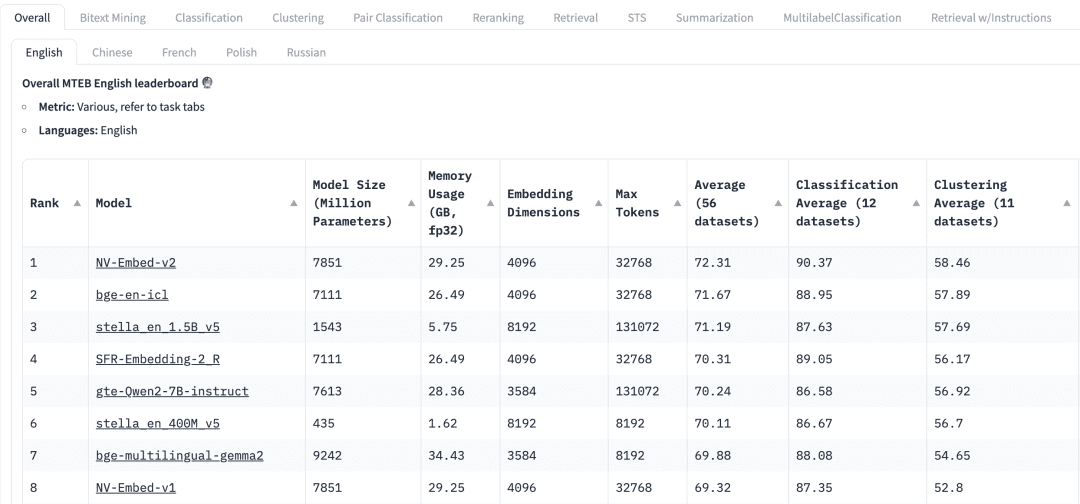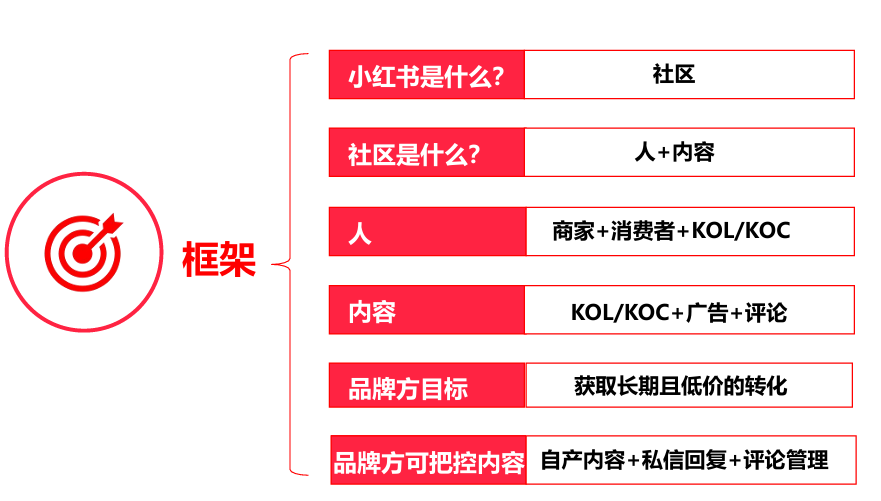
向量Embedding是目前检索增强生成(RAG)应用程序的核心。它们捕获数据对象(如文本,图像等)的语义信息,并以数字数组表示。在时下的生成式AI应用中,这些向量Embedding通常由Embedding模型生成。如何为RAG应用程序选择合适的Embedding模型呢?总体来说,这取决于具体用例以及具体需求。接下来,让我们拆分步骤来分别来看。
01.确定具体用例
我们基于RAG应用程序需求考虑以下问题:
首先,通用模型是否足以满足需求?
其次,是否有特定的需求?例如模态(如仅文本或图片,关于多模态Embedding选择参见《如何选择合适的 Embedding 模型》)、特定领域(如法律、医学等)
在大多数情况下,针对所需模态,通常选择通用模型。
02.选择通用模型
如何选择通用模型呢?HuggingFace中Massive Text Embedding Benchmark(MTEB)排行榜罗列了当前各种专有和开源文本Embedding模型,对于每个Embedding模型,MTEB列出了各种指标,包括模型参数、内存、Embedding维度、最大token数量,以及其在检索、摘要等任务中的得分。

在为RAG应用程序选择Embedding模型的时候,需要考虑以下因素:
任务:在MTEB排行榜顶部,我们会看到各种任务选项卡。对于一个RAG应用程序,我们可能需要更关注“检索”任务,我们可以选择 Retrial 这个选项卡。
语言:基于RAG应用的数据集语言来选择对应语言的Embedding模型。
得分:表示模型在特定基准数据集或多个基准数据集上的表现。根据任务的不同,使用不同的评估指标。通常,这些指标的取值范围在0到1之间,值越高表示性能越好。
模型规模和内存用量:这些指标让我们了解模型运行时所需的计算资源。虽然检索性能随着模型规模的增加而提高,但需要注意的是,模型规模也直接影响延迟。此外,较大的模型可能会过拟合,其泛化性能低,从而在生产中表现不佳。因此,我们需要在生产环境中寻求性能和延迟之间的平衡。一般来说,我们可以先从一个小的、轻量级的模型开始,先快速构建RAG应用。在应用的基础流程正常运行之后,我们可以切换到更大、性能更高的模型,来对应用做进一步优化。
Embedding维度:这是Embedding向量的长度。虽然更大的Embedding维度可以捕获数据中更细微的细节,但是效果不一定是最佳。例如,我们是否真的需要8192维度来处理文档数据呢?可能不需要。另一方面,较小的Embedding维度提供了更快的推理速度,并且在存储和内存方面更高效。因此,我们需要在捕获数据内容和执行效率之间寻求良好的平衡。
最大token数量:表示单个Embedding的最大token数量。对于常见的RAG应用程序,Embedding较好的分块大小通常是单个段落,此时,最大token为512的Embedding模型应该足够。然而,在某些特殊情况下,我们可能需要token数量更大的模型来处理更长的文本。
03.在RAG应用中评估模型
虽然我们可以从MTEB排行榜找到通用模型,但我们需要谨慎对待其结果。谨记,这些结果是模型的自我报告,有可能某些模型产生了夸大其性能的分数,因为它们可能在训练数据中包含了MTEB数据集,毕竟这些是公开的数据集。另外,模型使用基准的数据集可能无法准确代表我们应用里使用的数据。因此,我们需要在自己的数据集上评估Embedding模型。
3.1 数据集
我们可以从RAG应用使用的数据中,生成一个小型标记数据集。我们以如下数据集为例。
| Language | Description |
|---|---|
| C/C++ | A general-purpose programming language known for its performance and efficiency. It provides low-level memory manipulation capabilities and is widely used in system/software development, game development, and applications requiring high performance. |
| Java | A versatile, object-oriented programming language designed to have as few implementation dependencies as possible. It is widely used for building enterprise-scale applications, mobile applications (especially Android), and web applications due to its portability and robustness. |
| Python | A high-level, interpreted programming language known for its readability and simplicity. It supports multiple programming paradigms and is widely used in web development, data analysis, artificial intelligence, scientific computing, and automation. |
| JavaScript | A high-level, dynamic programming language primarily used for creating interactive and dynamic content on the web. It is an essential technology for front-end web development and is increasingly used on the server-side with environments like Node.js. |
| C# | A modern, object-oriented programming language developed by Microsoft. It is used for developing a wide range of applications, including web, desktop, mobile, and games, particularly within the Microsoft ecosystem. |
| SQL | A domain-specific language used in programming and managing relational databases. It is essential for querying, updating, and managing data in databases, and is widely used in data analysis and business intelligence. |
| PHP | A server-side scripting language designed primarily for web development. It is embedded into HTML and is widely used for building dynamic web pages and applications, with a strong presence in content management systems like WordPress. |
| Golang | A statically typed, compiled programming language designed by Google. Known for its simplicity and efficiency, it is used for building scalable and high-performance applications, particularly in cloud services and distributed systems. |
| Rust | A systems programming language focused on safety and concurrency. It provides memory safety without using a garbage collector and is used for building reliable and efficient software, particularly in systems programming and web assembly. |
3.2 创建Embedding
接下来,我们采用pymilvus[model]对于上述数据集生成相应的向量Embedding。关于 pymilvus[model] 使用,参见https://milvus.io/blog/introducing-pymilvus-integrations-with-embedding-models.md
def gen_embedding(model_name): openai_ef = model.dense.OpenAIEmbeddingFunction( model_name=model_name, api_key=os.environ["OPENAI_API_KEY"] ) docs_embeddings = openai_ef.encode_documents(df['description'].tolist()) return docs_embeddings, openai_ef
然后,把生成的Embedding存入到Milvus 的collection。
def save_embedding(docs_embeddings, collection_name, dim):
data = [
{"id": i, "vector": docs_embeddings[i].data, "text": row.language}
for i, row in df.iterrows()
]
if milvus_client.has_collection(collection_name=collection_name):
milvus_client.drop_collection(collection_name=collection_name)
milvus_client.create_collection(collection_name=collection_name, dimension=dim)
res = milvus_client.insert(collection_name=collection_name, data=data)
3.3 查询
我们定义查询函数,方便对于向量Embedding进行召回。
def query_results(query, collection_name, openai_ef):
query_embeddings = openai_ef.encode_queries(query)
res = milvus_client.search(
collection_name=collection_name,
data=query_embeddings,
limit=4,
output_fields=["text"],
)
result = {}
for items in res:
for item in items:
result[item.get("entity").get("text")] = item.get('distance')
return result
3.4 评估Embedding模型性能
我们采用 OpenAI的两个 Embedding模型,text-embedding-3-small 和 text-embedding-3-large,对于如下两个查询进行比较。有很多评估指标,例如准确率、召回率、MRR、MAP等。在这里,我们采用准确率和召回率。
准确率(Precision) 评估检索结果中的真正相关内容的占比,即返回的结果中有多少与搜索查询相关。
Precision = TP / (TP + FP)
其中,检索结果中与查询真正相关的内容 True Positives(TP), 而 False Positives(FP) 指的是检索结果中不相关的内容。
召回率 (Recall)评估从整个数据集中成功检索到相关内容的数量。
Recall = TP / (TP + FN)
其中,False Negatives (FN) 指的是所有未包含在最终结果集中的相关项目
查询 1:auto garbage collection
相关项:Java, Python, JavaScript, Golang
| Rank | text-embedding-3-small | text-embedding-3-large |
|---|---|---|
| 1 | ❎ Rust | ❎ Rust |
| 2 | ❎ C/C++ | ❎ C/C++ |
| 3 | ✅ Golang | ✅ Java |
| 4 | ✅ Java | ✅ Golang |
| Precision | 0.50 | 0.50 |
| Recall | 0.50 | 0.50 |
查询 2:suite for web backend server development
相关项:Java, JavaScript, PHP, Python (答案包含主观判断)
| Rank | text-embedding-3-small | text-embedding-3-large |
|---|---|---|
| 1 | ✅ PHP | ✅ JavaScript |
| 2 | ✅ Java | ✅ Java |
| 3 | ✅ JavaScript | ✅ PHP |
| 4 | ❎ C# | ✅Python |
| Precision | 0.75 | 1.0 |
| Recall | 0.75 | 1.0 |
在这两个查询中,我们通过准确率和召回率对比了两个Embedding模型 text-embedding-3-small 和 text-embedding-3-large 。我们可以以此为起点,增加数据集中数据对象的数量以及查询的数量,如此才能更有效地评估Embedding模型。
04.总结
在检索增强生成(RAG)应用中,选择合适的向量Embedding模型至关重要。本文阐述了从实际业务需求出发,从MTEB选择通用模型之后,采用准确率和召回率对于模型基于特定业务的数据集进行测试,从而选择最合适的Embedding模型,进而有效地提高RAG应用的召回准确率。
完整代码可通过下载获取
© 版权声明
文章版权归 AI分享圈 所有,未经允许请勿转载。
相关文章

暂无评论...




